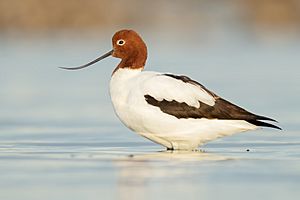Red-necked avocet facts for kids
Quick facts for kids Red-necked avocet |
|
|---|---|
 |
|
| Conservation status | |
| Scientific classification | |
| Synonyms | |
|
Recurvirostra rubricollis Temminck, 1820 |
The red-necked avocet (Recurvirostra novaehollandiae), also known as the Australian avocet, is a unique wader bird found only in Australia. It's related to stilts and is known for its elegant look and a special deep red head and neck. This bird is quite common across most of Australia, but you won't find it much along the northern and northeastern coasts. You might have even seen it on an Australian postage stamp in 1966!
Contents
About the Red-necked Avocet
The French scientist Louis Jean Pierre Vieillot first described the red-necked avocet in 1816. It still has the same scientific name today. This bird is one of four types of avocets that belong to the Recurvirostra group.
What Does It Look Like?
The most special thing about the red-necked avocet is its unique bill. It curves upwards, which helps the bird scoop up tiny creatures from the water's surface.
Adult avocets have a rich chestnut brown head and neck, which is how they got their name. They also have a thin white ring around their eyes and reddish-brown eyes. Their main wing feathers are black, but the rest of their body is white. Their bill is black, and their legs are a pale grey-blue.
Both male and female avocets look very similar in color and size. Their appearance doesn't change with the seasons either. Young avocets look a lot like adults, though their heads might be a bit paler.
An average adult red-necked avocet is about 43 to 45 centimeters (17 to 18 inches) long from head to tail. Its wingspan is around 75 centimeters (30 inches). These birds weigh about 310 grams (11 ounces).
When red-necked avocets call, it sounds like a yapping noise. If you hear a group of them flying, it might even remind you of dogs barking!
Where Do They Live?
Like many waterbirds in Australia, red-necked avocets move around a lot. This is because rainfall changes so much across the continent. They travel to find the best places to live.
They are found in many parts of Australia, but they are not common on the northern and northeastern coasts. These birds prefer salty or slightly salty water. You'll usually find them in shallow wetlands, whether the water is fresh or salty, or on muddy areas in estuaries. They are rare in Tasmania and sometimes visit New Zealand.
How Do They Behave?
Red-necked avocets usually live in loose groups during the breeding season. For the rest of the year, they spread out into smaller flocks. They are very social birds and get along well with stilts.
Before mating, male and female avocets perform special dances. They cross their bills and bow to each other. The female shows she's ready to mate by crouching low with her wings spread, usually in shallow water.
Each pair protects their nesting area. They use different displays and postures to warn off intruders. They will even swoop down repeatedly at anyone who gets too close.
Their calls are similar to other avocets. A common call is a clear, flute-like 'tuut' or 'kluut', which they use to keep in touch. They have shorter, sharper yelping sounds for warning calls. If conditions are good, they might stay in one place for a while. But if it gets dry, they will quickly move towards coastal areas.
What Do They Eat?
Red-necked avocets mainly eat small invertebrates. They catch these in shallow water by sweeping their thin, upward-curved bill from side to side. They move it through the water's surface and the mud underneath.
Unlike some other shorebirds, avocets can swim easily. This allows them to tip upside down, like a duck, to feed in deeper water. Their diet mostly includes water insects and their larvae, such as brine shrimp, and small crustaceans. They also eat seeds.
Young avocets mostly eat small insects and seeds until their bills are fully grown. They peck at their food instead of sweeping for it like the adults do.
Reproduction and Life Cycle
Red-necked avocets build their nests in loose groups, which are usually not very large. They mainly breed from August to November. However, this can change a lot depending on rainfall and how much water is available.
Breeding often happens in the southwestern inland areas, in swamps and mudflats, after it rains. Some small groups have also been seen nesting near Melbourne in Victoria.
Their nest is a shallow dip in the ground. It's lined with plants like samphire or other water plants. A female avocet usually lays 3 to 4 eggs, most often 4. The eggs are pear-shaped and pale brown with some speckled darker spots. Each egg is about 36 by 50 millimeters (1.4 by 2 inches). The eggs are placed in a circle, with the pointy ends facing the center.
Who Are Their Predators?
Because red-necked avocets are fairly large, they don't have many natural predators. However, animals like red foxes and feral cats, which were brought to Australia, can eat their chicks and eggs.
Climate change might also reduce the number of places they can breed inland. This could happen because of longer dry periods. To protect their young, red-necked avocets have been seen pretending to have a broken wing or leg. This clever trick helps them lure predators away from their vulnerable chicks.
See also
 In Spanish: Avoceta australiana para niños
In Spanish: Avoceta australiana para niños



